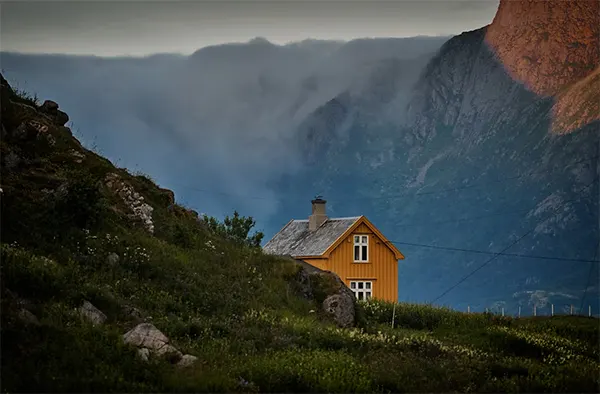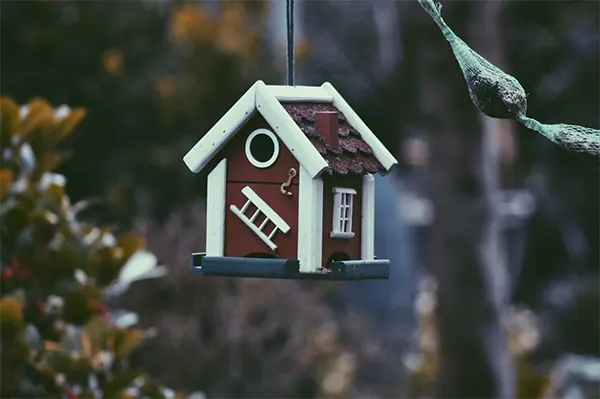Yes, it can be if you are considering a mortgage as a means of arranging for the required money. But you can also use your savings, personal loans, and chattel mortgage to fund the investment.

Tiny House Costs: Learn About Potential Expenses, Key Aspects, Financial Tips & More!

You might have truly wanted a house of your own, but hardly had the money to realize the dream. Don’t worry! Understand the concept of minimalistic living and tiny house costs in the article below, which will surely give you your dream house on a budget.
Analyze the cost of self-construction or the cost of purchasing a pre-made project. Moreover, take your curiosity further by going through the advantages and disadvantages of tiny homes, and some major financing options to arrange for the required funds. So, let’s start an insightful conversation right from the very beginning, without further delay.
- What is a Tiny House?
- How Much Does a Tiny House Cost?
- Tiny House Cost of Buying or Building
- The Cost of a Tiny House Based on Size
- Tiny House Cost Based on Types
- Factors Affecting Tiny House Costs
- What are the Advantages of Living in Tiny Houses?
- What are the Disadvantages of Living in Tiny Houses?
- Financing Tips for Investing in Tiny Living Spaces
- Conclusion
- FAQs
What is a Tiny House?

Before discussing the tiny house cost, let’s first look at what it is in general. Considering the typical size of the structure, tiny houses span from 100 to 400 square feet (ca. 37 m²). It is a housing arrangement that is considerably smaller than traditional residential setups.
Among developed countries, there has been a growing trend in residential construction that people are shifting from lavish and large houses to smaller and more economical units! This ideology has grown in recent years due to people now taking sustainable living and environmental protection more seriously than ever.
Exclusive Read: Complete Guide Showing How to Get a Florida Contractor’s License Quickly
How Much Does a Tiny House Cost?

Tiny house costs can normally range from $10,000 to $150,000 or anywhere around these limits. The price of a small residential unit is often influenced by many factors, such as size, materials used, customisation, design, unexpected costs, permit costs, etc. Thus, it is not a constant, but rather a variable.
Also Read: Discover 240+ Construction Company Names to Stand Out In the Market
Tiny House Cost of Buying or Building
It totally depends on the budget of the person who is willing to own a tiny house. Yet, on average, it will cost a person around $30,000 minimum to buy a tiny house, while the building would require the same person to spend approximately $35,000 on materials alone.
Thus, if you can afford the high cost of building a customised house, there is nothing to worry about in choosing to built over buy! A rough cost breakdown to construct a tiny house is mentioned below.
| Tiny House Cost Breakdown | |
| Factor | Average Cost |
| Land (For a Tiny House Built on a Foundation) | $6,000 – $20,000 |
| Foundation | $4,000 – $8,000 |
| Lot Rental (For a Wheeled Tiny House) | $300 – $2,000 |
| Trailer | $5,000 – $12,000 |
| Lumber, Framing or Sheathing | $2,000 – $15,000 |
| Roofing | $1,000 – $2,000 |
| Door and Windows | $1,000 – $6,000 |
| Insulation | $1,000 – $3,500 |
| Permits | $1,200 – $1,400 |
| Materials | $15,000 – $150,000 |
| Labour | Approximately $20 Per Hour |
Many people don’t have so much money that they can afford to build a customised tiny house for themselves. Thus, in that case, they might want to buy a simple yet functional ready-made property on wheels—a movable tiny house.
The Cost of a Tiny House Based on Size
The size of a tiny house is a key consideration. This is a major factor that influences the tiny house cost significantly. Consider the following table below for further analysis.
| Average Cost to Build a Tiny House as per Size | |
| Square Footage | Average Cost |
| 200 | $20,000 |
| 400 | $50,000 |
| 600 | $110,000 |
| 800 | $140,000 |
| 1,000 | $160,000 |
Look at the last entry, as it says that the most expensive build spanning 1,000 square footage will cost approximately $160,000. If that sounds expensive, choose a project that is smaller.
Also Read: Construction Bidding: Learn Meaning, Stages, Elements, Types, and More!
Tiny House Cost Based on Types
There are several types of tiny houses, so which one you have in mind is also a key factor that influences the total cost. Some major types are container, modular, traditional, micro-apartment, bus conversion, and small houseboat. Refer to the table below for relative costs.
| Average Tiny House Cost as per Type | |
| Types | Average Cost |
| Container Homes | $10,000 to $35,000 |
| Modular Homes | $13,000 to $40,000 |
| Traditional Tiny Cabins | $20,000 to $100,000 |
| Micro-Apartments | $57,000 to $2,00,000 |
| Bus Conversions | $1,00,000 to $1,20,000 |
| Small Houseboats | $6,000 to $1,500,000 |
If buying or building a traditional tiny house seems too expensive and out of your pocket, explore other options, such as buying a unit in a micro-apartment or converting your old bus into a movable tiny house property!
Factors Affecting Tiny House Costs
Major factors influencing tiny house prices are as follows.
- Size: This is a dominating factor in determining the cost of a tiny residential build. A project under 200 feet (ca. 61 m) is bound to get completed at a considerably lower cost than that of 400 feet (0.12 km)! A 200-feet tiny house costs $85,000 while the figure reaches $170,000 for a 400-feet project.
- Materials: The quality and quantity of construction materials impact the prices of a house significantly. For example, using high-quality timber wood pieces for type 5 construction, as compared to type 1 development, is often cheaper, but compromises on fire resistance. The cost can range from thousands to tens of thousands of dollars in approximation, as per project needs. Thus, it is crucial to learn about all the major types of construction to make an informed decision.
- Customisation: If you plan to build a tiny house as per your specific needs and preferences, it will increase the cost even further. It will require you to deploy professional tiny home designers who would ensure that you get every single feature you want, without having to augment the original size. However, buying an already-built small residence can cost less due to lower personalisation. The cost of customising a tiny house ranges from $50,000 to 175,000.
- Means of Acquisition: Whether you are building your project on your own or planning on buying an already-built project is also a key consideration. Building yourself might cost less, as you will at least save on labour charges.
- Location: The cost of residential construction varies from place to place. In an expensive, posh area, it will be higher than in a remote rural area. In the posh locations, a tiny house can approximately cost anything near $150,000. However, it is less expensive in economical localities, nearing up to $100,000 for the entire build.
Luxury features such as high-tech appliances, solar panels, compact toilets, protective door security features, and smart home technologies can increase the cost furthermore.
What are the Advantages of Living in Tiny Houses?
If you are looking for major reasons before making up your mind whether to invest in tiny homes or not, this section is for you. Consider all the constructive ways a cheap tiny house can contribute to enriching your overall life.
Major benefits are affordability, reduced maintenance, low environmental impact, simple & mindful living, financial freedom, mobility, and personalisation.
- Affordability: With lower development costs, tiny accommodations are the best if you need an affordable living space. There are lower utility expenses and reduced property taxes to create a win-win situation for the owner.
- Reduced Maintenance: With a small space and few compartments, there is no need to worry about high maintenance costs and associated discomfort. A small living space means less wear and tear, reducing the need for periodic fixes.
- Low Environmental Impact: Constructing and maintaining tiny houses often corresponds to lower carbon footprints. Such construction projects don’t need much time, space, or resources for construction.
- Simple & Mindful Living: When there is only space for necessary things, tiny house owners automatically start valuing home items and materials that are truly essential over unnecessary clutter. This constraint fosters simple and mindful living.
- Financial Freedom: When you consider financing a tiny residential facility rather than a big, full-fledged mansion, there is so much financial freedom. You don’t have to worry about high mortgage instalments. Even if you take a home loan to pay for your tiny dream dwelling, paying it off is going to be just a piece of cake.
- Mobility: If you are considering a little house built that is equipped with wheels, relocation ease is the biggest advantage for you to consider.
Lastly, small living spaces can be made as per one’s specific requirements, without major challenges. Whether a premade option or a self-building project, tiny accommodations are the best from the angle of high customisability or personalisation.
Also Read: What is a Submittal in Construction? Learn How Submittals Work and Why You Need to Focus on Them
What are the Disadvantages of Living in Tiny Houses?
While tiny living options are considerably cheaper as compared to conventional dwellings, there are certain unavoidable downsides. However, not every owner finds them a challenge. Have a look at all the major cons below.
- Construction Permission: Not every regional law allows for the development of tiny dwellings, thus posing a challenge to find a desired location where a project owner might start the build or find an already constructed facility.
- Limited Storage: Tiny accommodations are often underestimated due to limited living space. While minimalists promote it as the ultimate way to sustainability, certain dwellers find living in confined spaces challenging. Thus, little storage is the biggest flaw.
- Guest Hosting Issues: Tiny house owners frequently face major space issues when they plan to throw parties or celebrate important events indoors. However, this situation can be easily handled. Just consider an outdoor space for celebratory events like restaurants.
- Privacy Concerns: When considering multiple occupants, there can be severe privacy issues, as a tiny residential facility is only ideal for individual living. Rather than sharing a single tiny home, two owners must consider living in separate units.
Finally, limited space also poses challenges to reliably conducting indoor activities. No indoor games that involve 3 or 4 players can be played comfortably. However, entertainment activities involving 2 people can be easily managed.
Also Read: 10 Biggest Construction Companies in the US to Know Before Hiring a Contractor!
Financing Tips for Investing in Tiny Living Spaces

Tiny houses are cheaper than larger homes due to their smaller size and lower construction costs. They offer privacy on a low budget. If you’re considering building or buying one, consider the trio below for easier financing.
1. Savings
First, you should consider all your savings and calculate them together to know how much money you have at hand. After the calculation, set aside 50% of the amount for unexpected events or emergencies.
And, see if the rest of the 50% of your savings is enough to fund the tiny-house investment. This 50% rule is even more important if you are a salaried person.
2. Personal Loan
In case the money you have saved up isn’t enough, consider the option of taking a personal loan to fund the project. However, make sure that you have enough income flow to be able to manage EMIs without problems.
If the job security is shaky, don’t request a lot of money from the bank, as it will create difficulty if you lose your job.
3. Chattel Mortgage
In the case of a tiny house, the prospective owner cannot take advantage of the mortgage scheme that is easily available for large, traditional houses. It is so because even the minimum monetary limit doesn’t match the money needed when considering the tiny house cost. However, there is an alternative available: Chattel Mortgage.
This is a type of mortgage that can be leveraged by people who want to purchase movable property, which also includes a movable manufactured tiny house. However, the key limitation is that this mortgage is only available for movable property. Thus, if you don’t want a movable tiny house, you are not eligible and thus excluded from the list of beneficiaries.
Also Read: General Conditions of Contract: Complete Guide with Meaning, Types & Examples
Conclusion
So, through this article, you have amply learned about tiny house costs and how this type of residence can be a great option for many people longing to own a personal living space. This is so because not everyone can afford to buy a traditional household property due to monetary constraints.
However, even if you have enough savings to fund this investment, try financing your tiny house construction or purchase through personal loans if interest rates are reasonable. You might ask why! The reason is that it will help improve your CIBIL score, and as a result, the bank will charge a lower interest rate for future loans if you apply for any.
Also Read: What is a Contractor? Roles, Responsibilities & Everything to Know!
FAQs
Is it hard to finance a tiny home?
How long do tiny homes last?
Tiny homes last for decades or even a lifetime, depending on the quality of materials used and the frequency of on-time maintenance.
Is it safe to live in a tiny house?
If the material used is of high quality and fire-resistant, you have found a safe haven for your personal living. Also, check for robust security systems! Furthermore, never forget to take the help of a residential property safety inspector to see if there might be any potential issues.